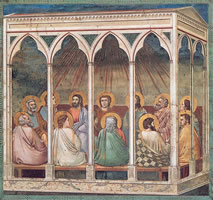 |
Pentecost Fresco by Giotto, c1305 |
When the day of Pentecost came, they were all together in one place. Suddenly a sound like the blowing of a violent wind came from heaven and filled the whole house where they were sitting. They saw what seemed to be tongues of fire that separated and came to rest on each of them. All of them were filled with the Holy Spirit and began to speak in other tongues as the Spirit enabled them. (Acts 2: 1-4)
Pentecost comes from Greek Pentékosté, meaning ‘fiftieth’. It originally referred to Shavuot, the Jewish ‘festival of weeks’. Celebrated on the fiftieth day after Pesach, Shavuot was connected with the first-fruits of the spring grain harvest, but came to be associated in Christianity with the descent of the Holy Spirit* on the Apostles.**
In Britain the festival of Pentecost is also known as Whitsun (Whitsunday), because of the white robes traditionally worn this day by those newly baptized the previous Easter. In Italy it was customary to scatter rose petals from the ceiling of churches in a symbolic re-enactment of the miracle of the fiery tongues. In France trumpets were blown during the service to recall the sound of the mighty wind which accompanied the descent of the Holy Spirit.
The Christian Pentecostal movement is so named because it emphasises the Holy Spirit is each individual; services are noted for worshippers falling into an ecstasy of inspiration and speaking in tongues.
**Perhaps as a result of this, the festival of Shavuot also became associated in Judaism with the manifestation of spirit, in that case the gift of the Torah to Moses on Mt Sinai.